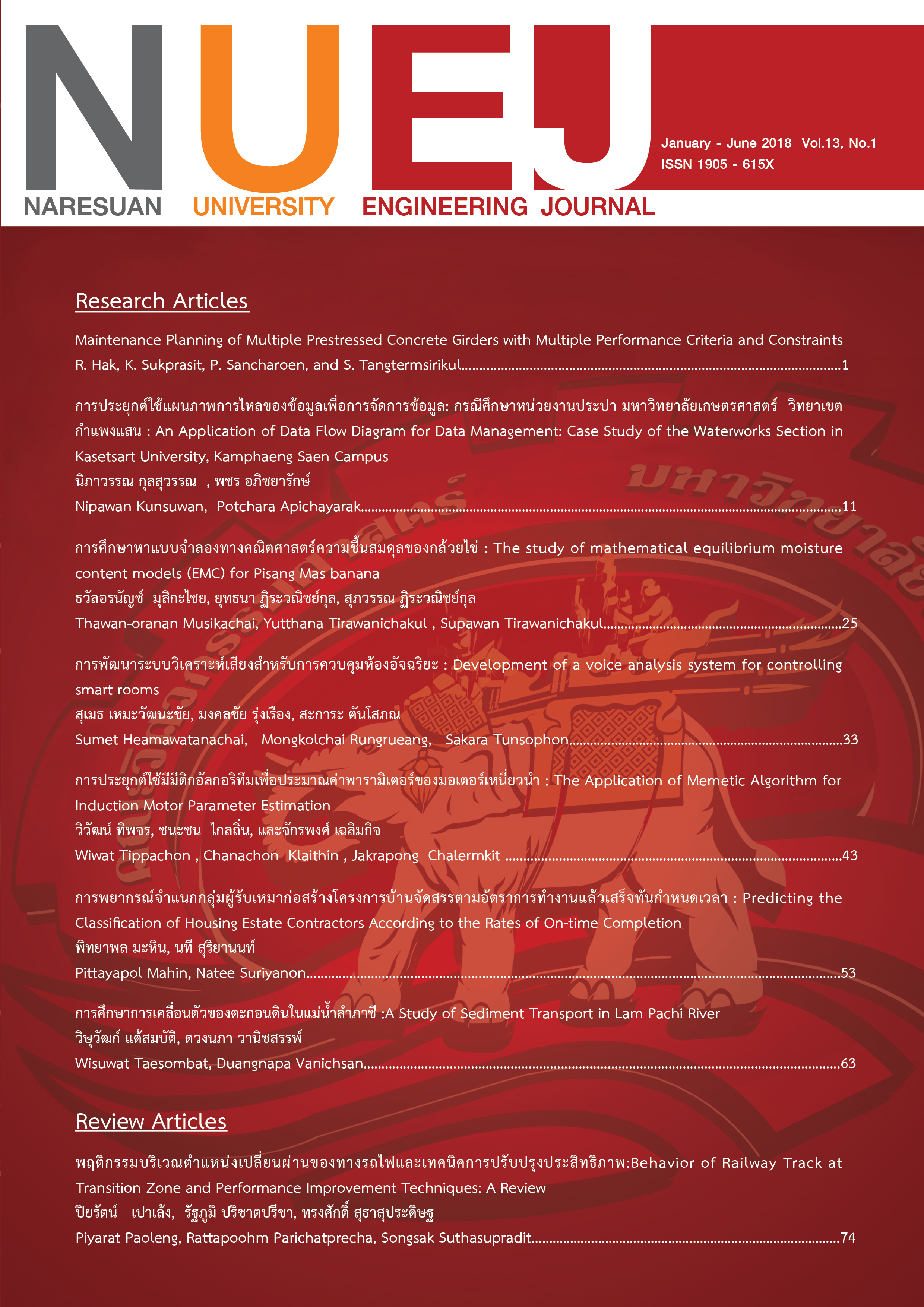A Study of Sediment Transport in Lam Pachi River
Main Article Content
Abstract
The purpose of this study was to simulate the hydrodynamic and sediment transport conditions in Lam Pachi River between a downstream portion of K.61 runoff station and a confluence of Kwae Noi River by an application of MIKE21-HD/ST model. First, observed data of river cross section, discharge, water level, and sediment in Lam Pachi River were collected during year 2013-2016. The result of calibration and verification of MIKE21-HD along Lam Pachi River has shown that the Manning’n roughness coefficient for the whole river was equal to 0.0286, which gave the calculated water level close to the observed values at K.62 runoff station. It provided a statistical index of R2 and RMSE equal to 0.79 and 0.54 m, respectively. The MIKE21-ST in conjugate with MIKE21-HD models were calibrated using steady state condition in the range of discharge from 5 to 100 m3 s-1 and measured sediment in three places along the river. It found that the average grain size was around 1.138 mm, unit weight of sediment was equal 2,675 kg m-3, average porosity was equal 0.28, and settling velocity was equal 0.1504 m s-1. The calibration results showed that the rate of bed level change had a sedimentation rate in the range of 0.33 to 0.64 m yr-1 and the sedimentation rate was directly proportional to the flow rate. Finally, MIKE21-HD/ST model was applied to analyze the annual sedimentation rate during year 2006-2015 by dividing into two case studies, namely 1) steady flow boundary condition and 2) unsteady flow boundary condition. The result showed that case 1 the average annual sedimentation rate was around 0.357 m yr-1 while case 2 the average rate was around 0.111 m yr-1. It found that the sedimentation rate of the steady flow case was higher than the sedimentation rate of the unsteady flow case on average approximately 32%. Since unsteady flow model simulation was more similar to the real flow condition in Lam Pachi River. However, sedimentation rate obtained from mathematical models was significantly higher than the actual because of sediment load input to the model was an average throughout the river. In fact, sediment load varied unequally both in each month and section of the river.
Article Details
References
Hardy, R.J., Bates, P.D., & Anderson, M.G. (2000). Modelling suspended sediment deposition on a fluvial floodplain using a two-dimensional dynamic finite element model. Journal of Hydrology, 229(3-4), 202-218.
Wu, W. (2004). Depth-Averaged Two-Dimensional Numerical Modeling of Unsteady Flow and Nonuniform Sediment Transport in Open Channels. Journal of Hydraulic Engineering, 130(10), 1013-1024.
Minh Duc, B., Wenka, T., & Rodi, W. (2004). Numerical Modeling of Bed Deformation in Laboratory Channels. Journal of Hydraulic Engineering, 130(9), 894-904.
Bourgoin, L. M., Bonnet, M.P., Martinez, J.M., Kosuth, P., Cochonneau, G., Moreira-Turcq, P., Guyot, J.L., Vauchel, P., Filizola, N., & Seyler, P. (2007). Temporal dynamics of water and sediment exchanges between the Curuaı´ floodplain and the Amazon River, Brazil. Journal of Hydrology, 335(1-2), 140–156.
Williams, D., Wolanski, E., & Spognol, S. (2006). Chapter 26 Hydrodynamics of Darwin Harbour. pp. 461-476. In The Environment in Asia Pacific Harbours. Springer, 498.
Taesombat, W. (2009). Two Dimensional Flow Modeling by Using MIKE21-HDFM Model for Darwin Harbour, Australia. Proceeding of 14th National Convention on Civil Engineering, Nakhonratchasima, Thailand, 13-15 May 2009.
Poulsen, J.B., Hansen, F., Ovesen, N.B., Larsen, S.E., & Kronvang, B. (2013). Linking floodplain hydraulics and sedimentation patterns along a restored river channel: River Odense, Denmark. The Journal of Ecological Engineering, 66, 120-128.
Puangpiw, A., & Taesombat, W. (2015). A Study of Sediment Transport in Pasak River Using MIKE21 Model. Thai Society of Agricultural Engineering Journal, 21(1), 45-55.
Van Rijn, L.C. (1984). Sediment Transport, Part I: Bed Load Transport. Journal of Hydraulic Engineering, 110(10), 1431–1456.
Vudhivanich, V. (2010). An Analysis of model accuracy using Nash-Sutcliffe Efficiency and R2. Chollakorn Journal.
U.S. Geological Survey. (2015). Groundwater Sources Have Their Origins in the Water Cycle and Are Held in Aquifers Beneath the Ground Surface, Available source: http://www.clean-water-for- laymen.com/groundwater-sources.html, Feb 14, 2017.


